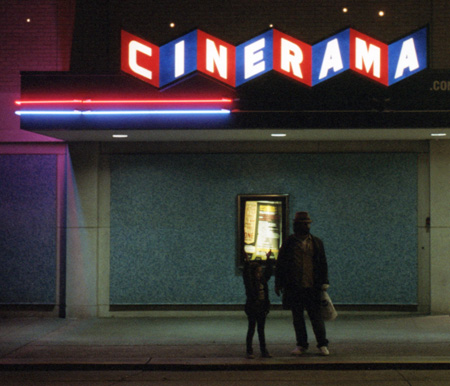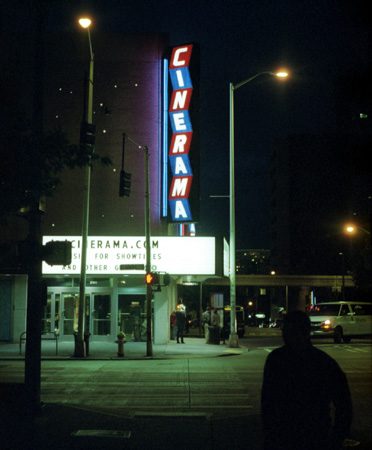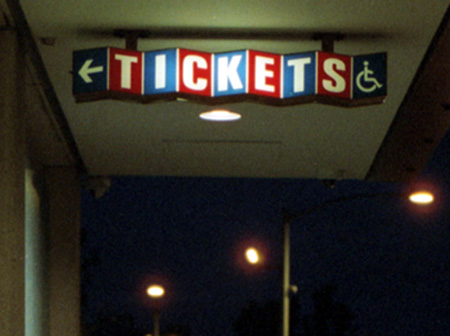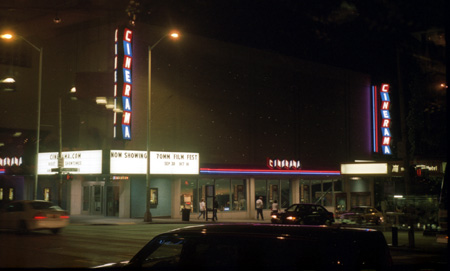Cinerama Festival - Seattle October 2011 | Read more at in70mm.com The 70mm Newsletter |
| Written and photographed by: Paul Sutton | Date: 14.10.2011 |
 8,000 miles is a long way to go to see a film but when that film is
"How The
West Was Won", and it is being shown in a three-strip Cinerama print said to
be ‘immaculate’, and it is being presented at a newly-restored 808-seat
cinema with a huge and glorious curved ribbon screen, and the screening is
supported by a repeated three-strip presentation of
"This Is Cinerama" and
thirteen, Thirteen! 70mm prints from the Hollywood studio archives, then I
was on the plane before I could tell my bank I’d left the country. The
result was that my bank cards were ‘blocked’ the moment the hotel clerk
tried to ‘swipe’ them. But no matter, I had the tickets in my hand, and a
‘Cinerama’ staff T-shirt on my back, a gift from the theatre’s dynamic young
manager Greg Wood. 8,000 miles is a long way to go to see a film but when that film is
"How The
West Was Won", and it is being shown in a three-strip Cinerama print said to
be ‘immaculate’, and it is being presented at a newly-restored 808-seat
cinema with a huge and glorious curved ribbon screen, and the screening is
supported by a repeated three-strip presentation of
"This Is Cinerama" and
thirteen, Thirteen! 70mm prints from the Hollywood studio archives, then I
was on the plane before I could tell my bank I’d left the country. The
result was that my bank cards were ‘blocked’ the moment the hotel clerk
tried to ‘swipe’ them. But no matter, I had the tickets in my hand, and a
‘Cinerama’ staff T-shirt on my back, a gift from the theatre’s dynamic young
manager Greg Wood. Greg had allowed me in early to give me the shirt and to let me take photographs of the foyer exhibits and the Cinerama-dressed concessions stand. Alas, popcorn is munched throughout the screenings, sometimes discreetly, but the cinema’s patented chocolate popcorn is delicious. The fizz-and-pop emporium is bordered by two display cases. In one case one could see four famous film costumes, including Sean Connery’s "Highlander" suit. In the other, perhaps as an apology for last week’s screening of "Rise of the Planet of the Apes", a shoddy animated film about ordinary uncostumed apes, one is treated to lifelike models wearing the costumes made for Roddy McDowell, Charlton Heston and Maurice somebody or other who played the orangutan, Dr Zaius, in the 1968 original. There were reproduction posters of the original Apes film and, semi-vintage posters of the two Cinerama films screening in this festival. The exhibits and the cinema belong to Paul G. Allen, co-founder of Microsoft and the kind of capitalist I like - he spends his money on the preservation and the celebration-through-exhibition of his country’s film culture. Elsewhere in town, at the science fiction museum now attached to the EMP (a music museum inside a twisted steel Frank Gehry), Allen’s collection of Battlestar Galactica spaceships, props, robots and costumes are on display. In the Horror Film exhibition curated by John Landis which opened there this same week, is Allen’s Alien - the very suit worn by Bolaji Badejo in Ridley Scott’s masterpiece. Then Greg said: "We’re running "This is Cinerama" through” in readiness for tonight’s screening. “Do you want to have a look?” A rush-hurdle up a flight of stairs and I was in the auditorium watching the results of a three-camera rig flying across the American landscape (location shots from "This is Cinerama" which eagle-eyed viewers will note are repeated, though reversed in "How The West Was Won"). Greg pointed out the theatre’s ‘sweet spot’, the best place to sit. Thankfully American cinemas have yet to succumb to the silly social control common in England of being told where to sit, or of having to ‘pick’ a seat without seeing the auditorium. Turn up, choose an empty seat is the system here. It works for me every time. An average of 400-500 tickets per show had been sold for the first week’s screenings, with ticket sales increasing to near capacity towards the end of the three-week season. The biggest ticket seller in the first week was "Lawrence of Arabia" with more than 700 tickets sold. | More in 70mm reading: Rare, Classic Films to Screen at Seattle Cinerama Theatre Internet link: |
First up, This Is Cinerama | |
 There was a real excitement in the auditorium and a good crowd of happy
chatty patrons - Seattle is like Dublin, a city where the folks are friendly
and happy to talk with strangers. A father with two small children in tow
explained he’d come along after seeing the Cinerama documentary on the
DVD of "How The West Was Won". “We’re going back to the Future, back to the
Fifties!” I said. A sixteen-year old who bemoaned the state of digital
cinema, after seeing silent film projected in 35mm at the 4,000 seater
Paramount cinema in Seattle, knew that seeing these prints was “possibly a
once in lifetime opportunity”. A cinema exhibitor from Millwauke boasted
with joy to a friend from Florida who could only stay for the weekend that
he was here for the whole week! There was a real excitement in the auditorium and a good crowd of happy
chatty patrons - Seattle is like Dublin, a city where the folks are friendly
and happy to talk with strangers. A father with two small children in tow
explained he’d come along after seeing the Cinerama documentary on the
DVD of "How The West Was Won". “We’re going back to the Future, back to the
Fifties!” I said. A sixteen-year old who bemoaned the state of digital
cinema, after seeing silent film projected in 35mm at the 4,000 seater
Paramount cinema in Seattle, knew that seeing these prints was “possibly a
once in lifetime opportunity”. A cinema exhibitor from Millwauke boasted
with joy to a friend from Florida who could only stay for the weekend that
he was here for the whole week!The majority of visitors to this site have seen "This is Cinerama", and so know that it is a fascinating combination of jaw-dropping spectacle and undeserved encores (why do the dullest sections get encores - the dance in Milan and the choir on the stone-dressed tennis court are fun for two minutes each so why do they run for plenty more and then for an encore? Particularly when there are other rollercoasters to ride? But the spectacle is so spectacular, and the Cinerama format so genuinely remarkable, that I write with sincerity, and as one who has seen more than four thousand films in a cinema, that when Lowell Thomas, who in standard black-and-white has taken us through the inventions and advances of cinema, says: “This is Cinerama!”, and the curtain pulls back on a rollercoaster starting its ride - the image filling the giant curved screen and the sound of the hoisting chains rattling forward - that we are witnessing one of the finest moments in all cinema. In Seattle in 2011, as in every theatre where this film has played in Cinerama, there were audience screams and gasps and exultations. This wasn’t an audience of 19th century French factory workers gasping at the sight on screen of a moving train, these were 21st century city-sophisticated Americans weaned on Wii and Imax. The spectacle in "This is Cinerama" is so astonishingly vivid and good, the print here so clean and clear, that I smiled more than I had done all year. I think I was still smiling in my sleep. “It makes Imax look like TV,” said the 16-year old. The following day, I took in another screening of "This is Cinerama" followed by the grandest and I think quite the most satisfactory Western ever made (it certainly has the finest female performance in Debbie Reynolds - strong, bold, poignant, funny and true). I’ve seen "How The West Was Won" before of course - in Bradford at the famous pleasure palace called Pictureville, but I had never before seen it like this. A flawless print. The magnetic sound in Seattle’s restored theatre is not to the standard of the sound system in Bradford where the separation is more advanced and the volume more aptly attuned to the auditorium, but the print here was better than I had dreamed it could be. It was printed, paid for and owned by Mr. Paul G. Allen. Seeing "How The West Was Won" in Seattle is the best time I have ever had in a cinema. | |
There were still the 70mm festival prints to come. | |
 In the morning, early, I went to one of Seattle’s two
IMAX cinemas to see
the new Imax film, "Canadian Mountain Railway" (adult ticket price for all
seats and all performances is $9, which would barely cover the cost of a
coffee in London). I enjoyed the film but it was earnestly educational as
Imax movies tend to be. There wasn’t a single moment where the filmmakers
thought ‘FUN!’. And of course the visuals lacked the colour and the depth
and the clarity of Cinerama. The sound was loud and clear. In the morning, early, I went to one of Seattle’s two
IMAX cinemas to see
the new Imax film, "Canadian Mountain Railway" (adult ticket price for all
seats and all performances is $9, which would barely cover the cost of a
coffee in London). I enjoyed the film but it was earnestly educational as
Imax movies tend to be. There wasn’t a single moment where the filmmakers
thought ‘FUN!’. And of course the visuals lacked the colour and the depth
and the clarity of Cinerama. The sound was loud and clear.The first film in the 70mm section of the Seattle festival was "West Side Story". What a print! and what a film! The projectionist cut off the feet of the dancers in some of the shots (a sin in dance-cinema) and a couple of messy reel changes (‘Did I just see a bit of leader?’) failed to dampen my enjoyment. It was introduced by a woman whose name I didn’t catch, but who told us all she had seen the film on its first release at Grauman’s Chinese and that her lasting memory of that occasion was that everyone watching it cried. It’s true it’s a film about tears and needless death, but as a work as cinema it is so electrifying - those finger-clicking jump edits in the opening sequence - that joy and sheer joy are the lasting emotions I felt when watching it here in 70mm. And I wasn’t alone. No one left their seats during the end credits. Almost every name in the credits was applauded. The print for "My Fair Lady" dated from a recent restoration [1994, editor] and possibly came with DTS sound - tinny and muffled to my atuned-to-Bradford-magnetic ears. The colours were all there but the print looked dark. A fault with the bulbs? Possibly. There was a noticeable difference in the brightness of the image as one reel changed to another. Some of the reel changes ‘popped’ noisily. But no matter. Surely they’d get things right for "Cleopatra" (next up) and for the evening’s masterpiece - "2001: A Space Odyssey"? "Cleopatra", or the Second-Half of the day’s Rex Harrison Double-Bill, was gorgeously in full-colour 70mm. Full intro music and intermission. I was so enjoying the film that I told a friend at the intermission: “Don’t worry, he’s going to give her a big diamond and it’s all going to end happily”. It didn’t in fact. The every-ten-minute ‘cannon-sounding DTS POP!’ to announce a reel change wasn’t quite getting irksome but it did have me worried for the presentation of the Kubrick. Thus the magic of my smile faded and Elizabeth Taylor as Cleopatra was doomed to die before her time because Richard Burton’s Antony lost his nerve during a sea battle. Is 70mm the Cinema of Tragic Death? "2001" brought in a big crowd. I watched it from the balcony and I watched it from the fourth row and it was glorious. In 70mm on a huge curved screen, the spaceships and the planets exude an awesome weight and depth that you just don’t get in any other format. Pleasingly this was a true Cinerama print with intro and interval music. I think it was also slightly trimmed. The “Open the pod bay doors, Hal,” scene, where Keir Dullea has rescued his ‘space walk’ colleague and tries to get back aboard the Jupiter craft, seemed shorter to me. Cinerama expert Matt Lutthans, who coincidently has probably the best private collection of Todd-AO, or Dimension 150, projectors in the world, and who ran the campaigns to save the Cinerama cinemas in Seattle and Omaha, was thrilled that the film was projected using a vintage 1963 lens, though he says the image quality was ‘slightly’ better when they screened it with a modern lens eight years ago. | |
 The following day brought an ‘easier’ triple-bill of immaculate full-colour
prints of Jacques Tati’s "Play Time" - a flop because of its overlong
twenty-minute scene of noisy jazz drumming at a restaurant’s first evening,
but best remembered for the delicious moment when a man puts a coin in a
slot to keep a merry-go-round of traffic going; "The Sound of Music" where
seven children are nursed by a snow white-haired Julie Andrews; and "Those
Magnificent Men in Their Flying Machines". The following day brought an ‘easier’ triple-bill of immaculate full-colour
prints of Jacques Tati’s "Play Time" - a flop because of its overlong
twenty-minute scene of noisy jazz drumming at a restaurant’s first evening,
but best remembered for the delicious moment when a man puts a coin in a
slot to keep a merry-go-round of traffic going; "The Sound of Music" where
seven children are nursed by a snow white-haired Julie Andrews; and "Those
Magnificent Men in Their Flying Machines". Jokingly, I arrived at the "Sound of Music" screening wearing my Cinerama staff T-shirt and announcing I didn’t need a ticket because I worked there. This backfired twenty-minutes after the film should have started when an angry blond-haired mother of was-it-seven-children? collared me and asked: “Is there anything wrong with the film?” “I don’t work here.” “Yes, you do!” It turned out there was a problem with the film. One of the teenage (?) members of staff announced with much apologising that they couldn’t get the soundtrack to play and that we could all have our money back. Some left. Others stayed. Half an hour later it was announced that they could now in fact play the film with sound (a nameless wit asked: “Did you find the right button to press?”). But play the film they did. At first, the reel changes popped and lifted their skirt to show a bit of leader, accompanied by the coming on of the house lights, then the soundtrack stopped working again. I gave up the screening to ride on the monorail built for 1962 World Fair. I went up the famous Space Needle and bought the DVD of Elvis Presley on location in Seattle in "It Happened At The World’s Fair". Then I was back at the Cinerama cinema for the 70mm screening of "Those Magnificent Men in Their Flying Machines". The print was lovely full colour; the soundtrack was very clear and loud. The title song was applauded, as was the first appearance on screen of Benny Hill - only the second actor to be accorded such acclaim at the festival - the first being John Wayne in "How The West Was Won". As I’m sure you all know, the film isn’t a classic, and far from the standard of "The Great Race" which screened at Bradford this year, but there are a few good lines and Terry-Thomas and Robert Morley are always worth watching. Morley’s performance here though mostly lacks the amusing/provincial wink-nudge twinkle of the ham who knows he’s a ham and who doesn’t care because he’s having fun and getting paid. I had a lot of fun at this First Seattle Festival of Cinerama Spectacle and 70mm Glory. I checked out the following day, before the DTS 70mm "South Pacific" could screen, to see an Imax 3-D print of "Born To Be Wild". Orphaned elephants and Dr Zaius orangutans. Earnestly educational? Check. But it was made with a rare understanding of photographic ‘depth’. I was impressed. Matt Lutthans told me that the print of "Chitty Chitty Bang Bang" was pink (and bang-banged) and screened at a time when parents couldn’t take their kids; that "Baraka" was glorious, and that the theatre got the sound right for the second screening of "Cleopatra". He reports that "Tron"’s magnetic soundtrack popped but that the print for "Lord Jim" was amazingly sharp. You could literally see the individual threads in O’Toole’s shirt. He reminded me of the curtain problems with "Play Time", which played in a format the novice projectionists hadn’t encountered before. They gave up after five attempts to get the framing right. I’m hopeful the presentation will be up to the consistently high standards of the prints the next time the big prints light up Seattle. I’ll be in the stalls. I’ll be watching from the balcony. I’ll be finding the very best place to sit for each screening. And I’ll be smiling wider than a Cinerama Smilebox restoration. | |
Getting to Seattle | |
|
British Airways probably run a non-stop service from London but their
‘premium prices’ and ready strikes make them a company to avoid. It’s also
worth avoiding flights that transfer at the busy internal airports - such as
Denver and Minneapolis - where the change over usually requires a minumum of
a four-hour wait (US customs are notoriously slow). Instead, the quickest
route is to fly to Seattle via Vancouver using Air Canada. There are plenty
of Vancouver to Seattle flights each day (journey time 50mins) which makes
for easy connections should the flight from London be delayed. There are
also regular and fairly cheap buses running between Vancouver and Seattle
airports. At Seattle airport, buy a $2.75 ticket for the light railway and ride it to the end of the line (Westlake). There is only one line. Westlake is downtown on 4th Avenue. The Cinerama Cinema is 400-yards away on the very same Avenue. | |
| Go: back - top - back issues - news index Updated 22-01-25 |
